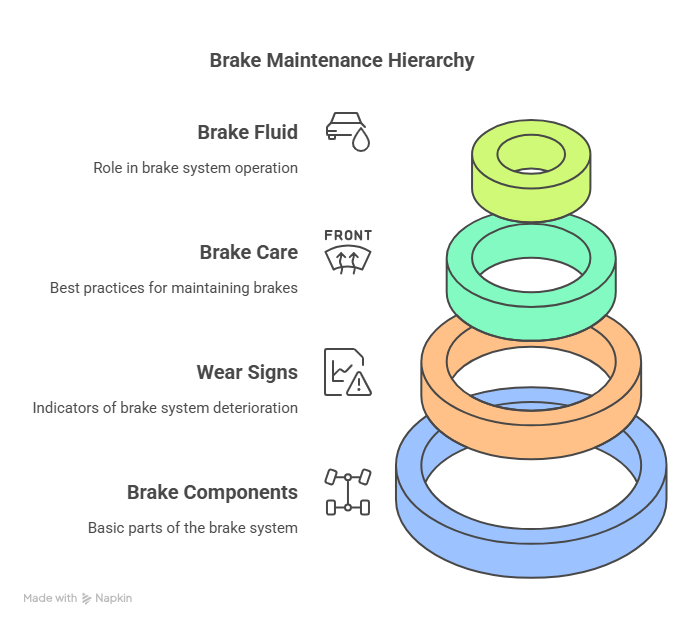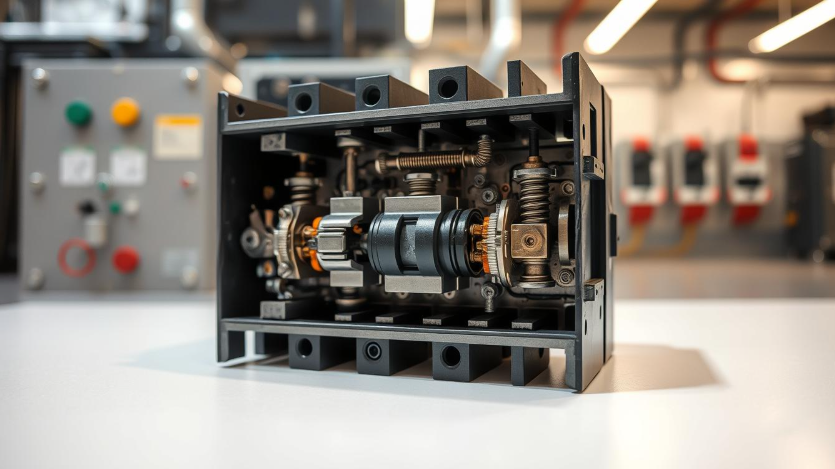Understanding car brake function is crucial for every driver. Your vehicle’s brakes are a critical safety feature, and knowing how they work can help you maintain them properly and drive more safely.
Car brakes are complex systems, but breaking down the basics can make them more accessible. In this guide, we’ll explore the fundamentals of brake operation and what you need to know to keep your vehicle stopping smoothly.
By the end of this article, you’ll have a solid grasp of the mechanics behind your car’s brakes and be better equipped to handle any issues that may arise.
Key Takeaways
- Understanding the importance of car brake maintenance
- Learning the basic components of a car’s brake system
- Recognizing the signs of brake wear and tear
- Discovering best practices for brake care
- Understanding the role of brake fluid in brake operation

The Basic Principles of How Brake Works
The braking system is a critical component of any vehicle, and its functionality is rooted in fundamental physical principles. Brakes are essential for safety, enabling drivers to slow down or stop their vehicles as needed.
The effectiveness of a brake system explanation depends on its ability to convert kinetic energy into another form, primarily through friction.
The Science of Friction and Hydraulics
Friction is a crucial element in the functioning of brakes. When the driver presses the brake pedal, it activates a hydraulic system that transfers pressure to the brake calipers. These calipers then clamp the brake pads onto the rotors (or drums in drum brakes), creating friction that slows the vehicle.
The hydraulic system is vital as it amplifies the force applied to the brake pedal, making it possible to stop a vehicle efficiently. This braking mechanism relies on the principles of physics to achieve the desired outcome.
Converting Motion Energy to Heat
The primary function of brakes is to convert the kinetic energy (motion energy) of a moving vehicle into heat energy, which is then dissipated. This process occurs through the friction generated between the brake pads and the rotors or drums.
- Kinetic energy is converted into heat energy.
- Friction between brake pads and rotors or drums slows the vehicle.
- Heat is absorbed by brake components and released into the atmosphere.
Essential Components of a Car Brake System
To comprehend how car brakes work, it’s essential to examine the critical parts that make up the braking system. The car’s brake system is a complex assembly of components designed to slow or stop the vehicle. Understanding these components is vital for maintaining and troubleshooting the braking system.
Brake Pedal and Master Cylinder
The brake pedal is the interface between the driver and the braking system. When pressed, it activates the master cylinder, which converts non-hydraulic pressure from the brake pedal into hydraulic pressure. This hydraulic pressure is then transmitted through the brake lines to the other components of the braking system.
Brake Lines and Fluid
https://www.youtube.com/watch?v=2PER9knUZpIBrake lines and fluid play a crucial role in the braking system. The brake fluid carries the hydraulic pressure from the master cylinder to the brake calipers. It’s essential that the brake fluid is maintained at the correct level and is free from contamination to ensure the proper functioning of the brakes.
| Component | Function |
|---|---|
| Brake Pedal | Interface between driver and braking system |
| Master Cylinder | Converts non-hydraulic pressure to hydraulic pressure |
| Brake Lines | Transmit hydraulic pressure |
| Brake Fluid | Carries hydraulic pressure to calipers |
Calipers, Pads, and Rotors
The calipers house the brake pads, which are pressed against the rotors to slow or stop the vehicle. The rotors are attached to the wheels and rotate with them. When the brake pads come into contact with the rotors, friction is generated, converting the vehicle’s kinetic energy into heat energy, thus slowing it down.
“The braking system is a critical safety feature of any vehicle, and understanding its components is essential for maintaining vehicle safety and performance.”
Different Types of Braking Systems
Understanding the different types of braking systems is crucial for appreciating the complexity of modern vehicles. Braking systems are not one-size-fits-all; they vary based on the vehicle’s design, intended use, and technological advancements.
Disc Brakes vs. Drum Brakes
Disc brakes and drum brakes are two primary types of braking systems. Disc brakes use a rotor attached to the wheel hub and a caliper that clamps the brake pads onto the rotor to stop the vehicle. They offer better heat dissipation and are generally more effective, especially in wet conditions.
Drum brakes, on the other hand, use a drum and shoes that press against the drum’s inner surface to create friction. While they are less expensive to produce and maintain, they can be less effective, especially when they overheat.
Anti-lock Braking Systems (ABS)
Anti-lock Braking Systems (ABS) prevent the wheels from locking up during hard braking, maintaining traction and preventing skidding. ABS works by rapidly pulsing the brakes on and off, allowing the driver to maintain control of the vehicle.
Regenerative Braking in Modern Vehicles
Regenerative braking is a technology used in hybrid and electric vehicles to capture some of the kinetic energy that would be lost as heat during braking and convert it back into electrical energy. This process not only improves efficiency but also reduces wear on the brake components.
By understanding these different braking systems, vehicle owners can better appreciate the technology that keeps them safe on the road.
Conclusion: Maintaining Your Brakes for Safety
Understanding how your car’s brake system works is crucial for maintaining vehicle safety. As discussed, the brake system explanation reveals a complex interplay of components, including the brake pedal, master cylinder, brake lines, calipers, pads, and rotors, all working together to enable safe stopping.
Regular maintenance of your car’s brakes is essential to ensure they function properly. This includes checking brake fluid levels, inspecting brake pads and rotors for wear, and addressing any issues promptly. By taking proactive steps, you can significantly reduce the risk of brake failure and maintain your vehicle’s safety on the road.
A well-maintained brake system not only enhances safety but also contributes to the overall performance of your vehicle. By staying informed and vigilant about your car’s brakes, you can drive with confidence, knowing you’re protected against potential hazards.
FAQ
How do brakes work in a car?
Brakes work by using friction to convert the kinetic energy of a moving vehicle into heat energy, thereby slowing or stopping the vehicle. The process involves the brake pedal, master cylinder, brake lines, calipers, pads, and rotors working together to achieve this.
What is the role of brake fluid in the braking system?
Brake fluid plays a crucial role in the braking system by transmitting pressure from the brake pedal to the brake calipers, allowing the vehicle to slow or stop. It operates within the brake lines and master cylinder to facilitate this process.
What is the difference between disc brakes and drum brakes?
Disc brakes use a rotor attached to the wheel hub and calipers that clamp onto the rotor to stop the vehicle, offering better heat dissipation and stopping power. Drum brakes, on the other hand, use a drum attached to the wheel hub and shoes that press against the drum’s inner surface to stop the vehicle, generally being less effective at heat dissipation.
How does an Anti-lock Braking System (ABS) work?
ABS works by rapidly pumping the brakes on and off to prevent the wheels from locking up during hard braking, thus maintaining traction and preventing skidding. This enhances vehicle control and safety, especially on slippery surfaces.
What is regenerative braking, and how does it work?
Regenerative braking is a technology used in hybrid and electric vehicles that captures some of the kinetic energy that would be lost as heat during braking and converts it back into electrical energy, which is then stored in the vehicle’s battery, improving efficiency and reducing wear on the brake components.
Why is brake maintenance important for vehicle safety?
Regular brake maintenance is crucial for ensuring vehicle safety as it helps to identify and address any issues before they become major problems, such as worn-out brake pads or leaking brake fluid, which can lead to brake failure and accidents.
How often should brake pads be replaced?
The frequency of replacing brake pads depends on various factors, including driving conditions, vehicle type, and manufacturer recommendations. Generally, brake pads should be inspected regularly, and replaced when they reach the minimum thickness specified by the manufacturer, typically between 30,000 to 50,000 miles.
What are the signs of failing brakes?
Signs of failing brakes include squealing or grinding noises when applying the brakes, a spongy or soft brake pedal, vibrations when braking, and an illuminated brake warning light on the dashboard. If you notice any of these signs, it’s essential to have your brakes inspected and serviced promptly.




